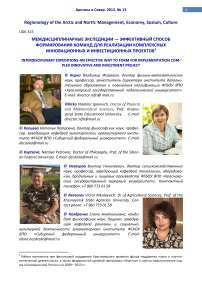Interdisciplnary expeditions - an effective way to form implementation complex innovative and ivesment projects
Автор: Kirko V.I., Kopzeva N.P., Nevzorov V.N., Nozdrenko E.A., Slabyha A.V.
Журнал: Arctic and North @arctic-and-north
Рубрика: Regionology of the Arctic and North: Management, Economy, Sozium, Culture
Статья в выпуске: 13, 2013 года.
Бесплатный доступ
In the given article we represent our final results of the inter-disciplinary expeditions of the students, post-graduate students and tutors of the 4 universities of Krasnoyarsk to the villages and localities, inhabited by the indigenous minorities of the North of the Krasnoyarsk Region.
Indigenous minorities, interdisciplinary expeditions, students, post-graduate students and tutors
Короткий адрес: https://sciup.org/148319881
IDR: 148319881 | УДК: 315
Текст научной статьи Interdisciplnary expeditions - an effective way to form implementation complex innovative and ivesment projects
In 2010-2012, Siberian Federal University became the owner of the grants of the the federal target program (FTP) "Scientific and scientific-pedagogical personnel of the innovative Russia", grant of the Krasnoyarsk Regional Science Foundation (KKFN) [1-5]. The main purpose of the grant was to conduct interdisciplinary research complex onthe level of quality of life of small indigenous people of the north of the Krasnoyarsk Territory, the preservation of their traditional activities and national culture in the face of the global transformation, the development of a modern model of the northern settlement in the areas where indigenous people engaged in the traditional crafts.
To achive this goal were named several tasks:
-
a) Investigate the features of construction and arrangement of housing .
-
b) To carry out architectural and planning field research communities.
-
c) To develop the architectural and planning model of the modern northern village.
-
d) To develop a model of heat and power to the northern towns.
-
e) To consider for the modernization of health care in the Far North.
-
f) To develop a generalized model of innovation and production, aimed at food selfsufficiency villages, deep processing of local agricultural raw materials, the development traditional handicrafts and tourism, etc.
For this study were formed interdisciplinary expeditions, the composition of which were included undergraduate and graduate students and three teachers of universities in Krasnoyarsk, namely the Siberian Federal University (SFU), Krasnoyarsk State Agricultural University (KGAU) and Krasnoyarsk State Medical University (KSMU). The expedition was attended by the cultural studies, art historians, architects, builders, engineers, physicists, farmers and managers.
Expeditions were sent to the northern towns of the Krasnoyarsk Territory - Local places where indigenous people were engaged in the traditional activities: hunting, herding, fishing and gathering wild plants, etc. These four villages of three municipalities in the north of the Krasnoyarsk Territory.
The settlement Surinda [6] Evenk municipal district (MP) is the local Evenki living in the taiga zone (480 pers.). The main type of occupation – are reindeer breeding in the MP OPH "Surindinsky" and hunting.
Essene settlement [7] Evenk MP is a local residence segregated ethnic community - Essene Yakuts (620 pers.). It is located above the Arctic Circle to the shores of the largest lake in the Krasnoyarsk Territory in the forest-tundra zone. Main type of activity of the population - are the fishing and hunting.
Nosock village [8] Taimyr Dolgan-Nenets MP located at the mouth of the Yenisei River in the Arctic Circle in the tundra zone. Its population is (as of 01.01.2011) 1800 people of which 1500 - Nenets. The nomadic ways of life are 1,107 people (232 families). Main type of activity of the population – are herding and fishing.
The settlement Farkovo [9] MR Turuhanskogo Krasnoyarsk Territory – is the only place in the province of the local residence Selkups (410 pers). Main types of activity of the population – are fishing and hunting.
Pic. 1 shows photographs of the members of the interdisciplinary expeditions (FAS representatives, KSMU KGAU) in the northern towns of the Krasnoyarsk Territory.
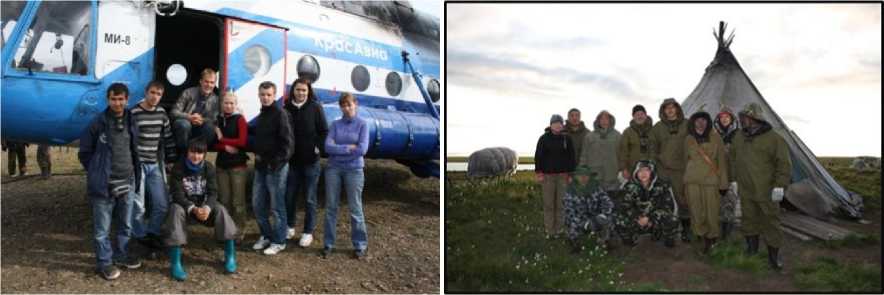
а
б
Pic. 1. Interdisciplinary expeditions undergraduate and graduate students of the Siberian Federal University (SFU), Krasnoyarsk State Medical University (KMGU) and Krasnoyarsk State Agricultural Universities University (KGAU): a - a claim that was the Tour village. Surinda and settlement. Essey Evenk a municipal district *, b - in the village. Nosok and settlement. Guard Taimyr Dolgan-Nenets Municipal District of Krasnoyarsk Territory**.
-
* From left to right: S. Gladkiy (SFU graduate student, architect), K. and B. Fissenko Lohaykin (5-year SFU students, architects), A. Cherepanov (SFU graduate student, engineer and physicist), L. Fatkulina (5th year student of SFU , a civil engineer), A. Kopitsa (dentist, graduate of SFU), A. and M. Radova Kolesnik (5th year student of SFU, culture). Bottom row: V. Soviets, S. Soroka (5-year SFU students, civil engineers).
-
**From left to right: L.Fatkulina (5th year student of SFU, a civil engineer), and M.Yamkin Yaptunay Celi (fishermen village. Sock, Nenets), VI Kirko (Professor SFU), VV Zakharyuta (SFU graduate student, a civil engineer), I. Kugappi (5th year student of SFU, cultural), K. Reznikov (SFU graduate student, cultural); wenge WH (Deputy Head of the Administration of the rural settlement Sentry).
The expeditions in their work used several methods:
-
a) Survey and in-depth interview residents of settlements, township heads of administrations, experts in education, health care, preservation of national culture, architecture (arrangement) of settlements, construction of the new and old housing.
-
b) To design workshops on the development of theindustrial activities in the field of deep processing of the local agricultural raw materials and new mini-production for selfsufficiency settlements adequate food and clean water.
-
c) Visual inspection of buildings and structures, state of the energy sector and infrastructure
projects such as roads, sewer and burial.
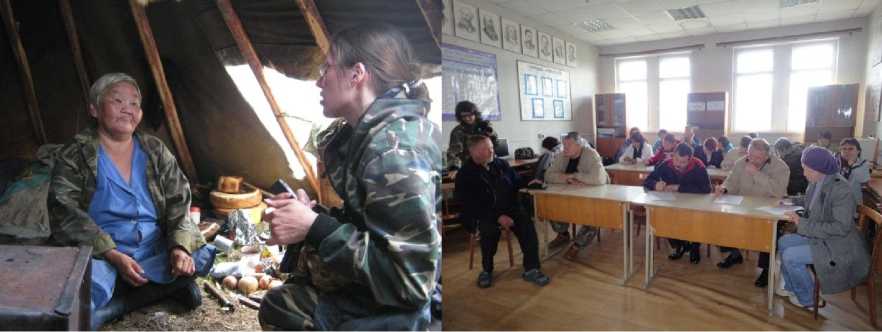
а б
Pic. 2. In-depth interviews with nomad herders in the brigade MP OPH "Surindinsky", 2010 (a);
Village residents fill out the questionnaire. Nosok at the project seminar, 2011 (b)
The main results were published in the ethno-cultural collective monograph [10] and in [11-15].
Ethno-cultural studies have shown major problems:
-
a) Education and the availability of the modern high-quality education according to the na-
- tional circumstances of the life and culture of the indigenous people (settled in remote villages and / or nomadic herding in teams).
-
b) The preservation of language and national ethno identity.
-
c) Close relationship to preserve the culture of indigenous people from their tradtional way of the life and the traditional crafts.
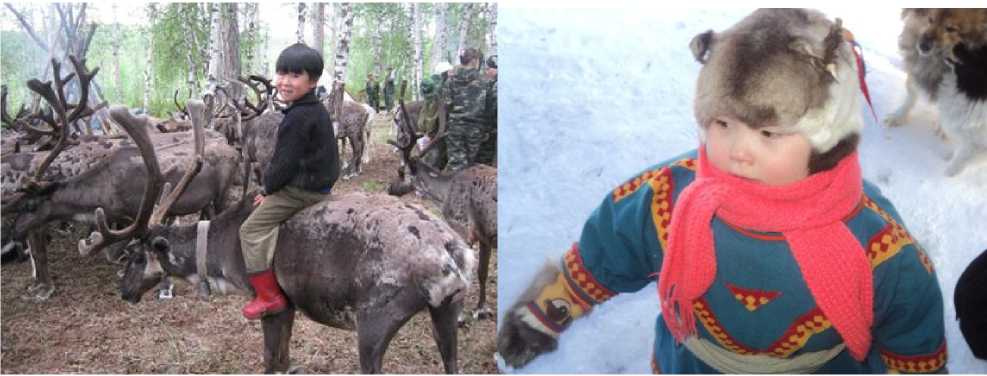
а б
Pic. 3. Future foreman reindeer brigades Borka (a) settlement. Surinda Evenki MR; future hunter or fisherman village. Nosok Taimyr Dolgan-Nenets MP (b)
In [11, 16] as one of the measures to address the problems of the proposed establishment of the Higher School of the northern Siberian Federal University, the main task of which is expected to increase knowledge of the children of the indigenous people to the level comparable to the level of knowledge of the urban schools children for the subsequent delivery of the unified state examination for the admission to the universities of Russia.
The results of evaluation of buildings and structures of the settlements of the North of the
Krasnoyarsk Territory published in [17-18]. Studies have shown currently existing high degree of contrast in the possibility of their use: from the emergency state (Fig. 4a) to the modern highest requirements (Pic. 5). Some objects do not meet the simple requirements to housing (Pic. 4b).
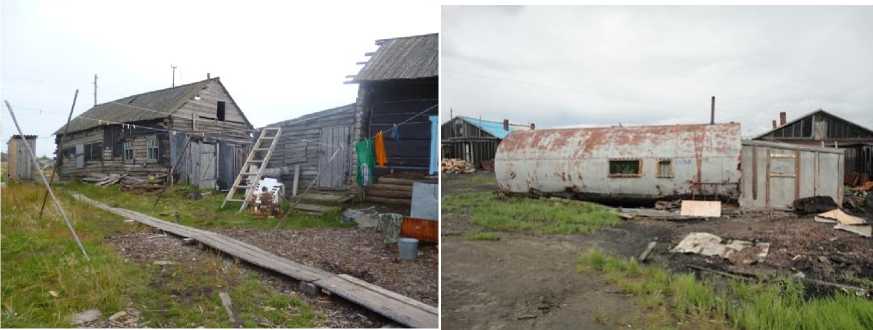
а б
Pic. 4. Some residential group (a) in the village. Essey (Evenki MP) in the village.
Sock (Taimyr, Dolgan-Nenets MR) (b)
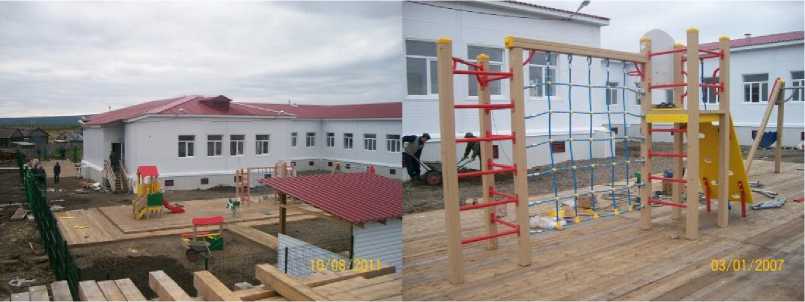
Pic. 5. Kindergarten in the village. Essey that meets the highest standards of the construction and performance
The results of the evaluation of the thermal power complex and possible solutions to re- duce the cost of electricity by the example of the village. Sock and settlement. Essey published in [19]. To generate electricity in the villages are mostly used diesel power, the wear which reaches 80-100%. Despite this, in the Evenki MR equipment DES (Fig. 6) is contained in a perfect condition (Head MP EMR "Ilimpiyskie power" N. A. Supryaga.
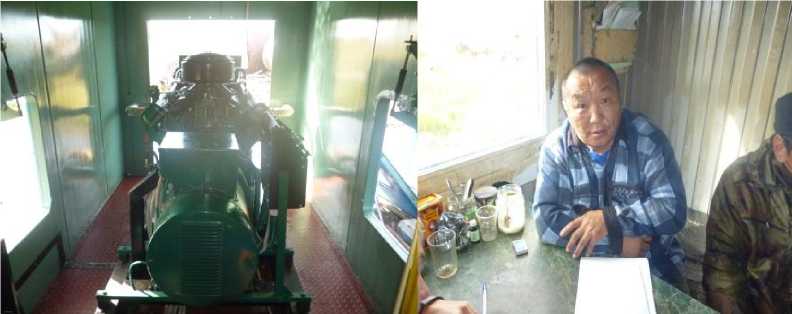
а б
Pic. 6. Diesel power in the village. Essene (a) and the village chief electrician A. N. Maymaga (b) (Evenki MP)
Price per kWh in the villages of the northern Krasnoyarsk region ranges from 20 to 30 rubles. In this regard, for the further development of their productive competitiveness is an issue to reduce the cost of thermal power generation. In [19] as an the example of the village Nosock and settlement Essey shows the possibility of reducing the cost of electricity is 2-3 times through the use of a combined version of the diesel and wind power plants.
As noted above, in the villages of the northern territories of Krasnoyarsk villages, the traditional activities, such as reindeer herding, hunting, fishing, gathering, etc. This is the basis of their existence [20-21]. However, there are problems that do not allow full use of the resource potential of the North. These challenges are, first of all, the cost of electricity, clean water, deep processing of the products of nature (meat, fish, hides, wild plants, etc.), transportation and sales.
In [22], a locally based production model remote village. The model involves the creation of the settlements in the mini-productions of two types: production, aimed at self town’s products for their own consumption (processing of milk, meat, and fish); productions aimed at the production of products with high added value. Pic 7 shows photographs of the high-tech mini-production of deep processing of reindeer antlers in the village Surinda. The author of the project - Professor, Doctor of Agricultural Sciences V. Nevzorov (Krasnoyarsk State Agricultural University).
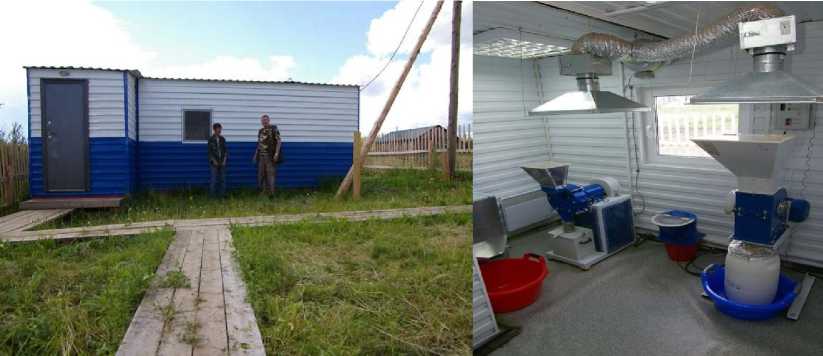
Pic. 7. Objects of high-tech mini-production of deep processing antlers of reindeer in the village. Surinda
The main feature of these plants is that the design and installation of the equipment is in a container, certification of production and training takes place in Krasnoyarsk. The village is made with site preparation summing electricity and water. Shipping is on water or thoroughfares, or by winter road.
The students and graduate students of the Institute of Civil Engineering and the Institute of Architecture and Design SFU (for example, pos. Essey Evenk MP ) developed variants of planning architectural designs in locally villages located in remote tundra and forest-tundra zones [17, 18, 23 , 24]. In the development of the architectural models take into account the ethnic and cultural landscape and geographical features, the modern conception of the ecological preservation of the environment, economy of heat and electricity. Pic 8 shows the traditional national architectural forms of the northern towns - chum (a) and Hal (b).

а б
Pic 8. Traditional architectural forms of housing in the northern settlements: a - tent (village Sock) and b -Hal (village Essey, Evenkiya, Krasnoyarsk region, pos. Hodorgoy, Yakutia)
Pic. 9. Architectural forms, projected on the basis of use of the composition tent - Hal basic properties of the composition tent - Hal, is offered in 23, 24], which forms a cone-shaped structure like a tent, and multi-faceted as Hal. In addition, the proposed basic principles of the spatial urbanization in the case of the design of the new northern towns.
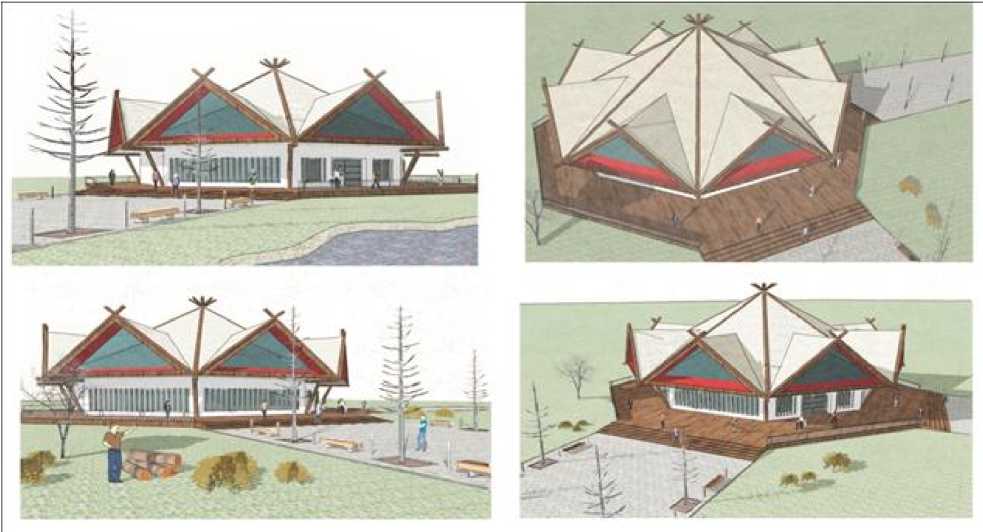
So, in this paper we show that a form of interdisciplinary expeditions of the students and teachers from various universities allows you to have:
-
a) A comprehensive approach to the problem of locally situated towns, including places where indigenous people.
-
b) Propose solutions interrelated problems with the ethno-cultural characteristics and traditions.
-
c) Effectively prepare students for creative work in a team on the real objects.
While working on the project three teachers were protected and prepared a master's thesis, masters were protected five master's theses, students are protected eight theses and projects.
Список литературы Interdisciplnary expeditions - an effective way to form implementation complex innovative and ivesment projects
- Коренные и малочисленные народы Севера в условиях глобальных трансформаций // Отчет по гранту ФЦП «Научно-педагогические кадры инновационной России». Сибирский федеральный университет. Красноярск: СФУ, 2010—2012.
- Разработка научных основ формирования структуры региональной инновационной платформы и механизмов ее создания на основе взаимодействия автономных образовательных учреждений с территориально-административными образованиями (на примере Красноярского края и Сибирского федерального университета) // Отчет по гранту ФЦП «Научно-педагогические кадры инновационной России». Сибирский федеральный университет. Красноярск: СФУ, 2010—2012.
- Социальное конструирование общероссийской национальной идентичности и самоидентичности в системе культуры региона — субъекта Российской Федерации (на материале Красноярского края) // Отчет по гранту ФЦП «Научно-педагогические кадры инновационной России». Сибирский федеральный университет. Красноярск: СФУ, 2010.
- Формирование структуры регионального инновационного кластера и механизмов его создания на основе взаимодействия автономных образовательных учреждений с ТАО (на примере Красноярского края и Сибирского федерального университета) // Отчет по гранту Красноярского краевого фонда науки и научной деятельности. Сибирский федеральный университет. Красноярск: СФУ, 2010.
- Красноярский край — поликультурное пространство, родина коренных и малочисленных народов Севера // Отчет по гранту Красноярского краевого фонда науки и научной деятельности. Сибирский федеральный университет. Красноярск: СФУ, 2010.
- Cуринда. URL: http://ru.wikipedia.org/wiki/%D1%F3%F0%E8%ED%E4%E0 (дата обращения: 14.03.2013).
- URL: http://www.evenkya.ru (дата обращения: 14.03.2013).
- Носок: сайт. URL: http://www.taimur-karaul.ru/pages/nosok (дата обращения: 14.03. 2013).
- Коренные народы Красноярского края: сайт. URL: http://www. krskstate.ru/ society/ nations/aborigen (дата обращения: 14.03.2013).
- Копцева Н.П. Коренные малочисленные народы Севера и Сибири в условиях глобальных трансформаций на материале Красноярского края / Н.П. Копцева, В.И. Кирко, А. В. Кеуш, Е.А. Ноздренко и др. Красноярск: Сибирский федеральный университет, 2012.
- Nozdrenko Е. А. Adaptation of Indigenous Youth from Northern Territories to Studing at University: Establishment of the Higher Northern School in Siberian Federal University / Е. А.Nozdrenko, N. Koptseva // Journal of Siberian Federal University. Humanities & Social Sciences 2012. Vol. 2, № 5. Pp. 232–242.
- Koptseva N. P. Indigenous peoples of Krasnoyarsk region: concerning the question of methodology of culture studies / Journal of Federal University. Humanities & Social Sciences 2010. Vol. 4, № 3. Pp. 554–562.
- Koptseva N. P. Protection and Development of the Indigenous Peoples Livingin Circumpolar Territories: Cultural and Anthropological Analysis / N. P. Koptseva, N. N. Pimenova, K. V. Reznikova // Journal of Siberian Federal University. Humanities & Social Sciences 2010. Vol. 5, № 3. Pp. 649–666.
- Koptseva N. P. Linguistic-Culturological Peculiarities of National Languages of the Northern People of the Krasnoyarsk Region / N. P. Koptseva, A. N. Khizhnyakova, K. V. Reznikova // Journal of Siberian Federal University. Humanities & Social Sciences 2011. Vol. 3, № 4. Pp. 323–341.
- Koptseva N. P. Classical and Contemporary Approaches to Ethno-Cultural Studies. The Kernel of Ethnos / N. P. Koptseva, N. A. Bakhova, N. V. Medyantseva // Journal of Siberian Federal University. Humanities & SocialSciences 2011. № 4. Pp. 615–632.
- Копцева Н. П. Этнопедагогические подходы в Сибирском федеральном университете: идея Северной школы для коренных малочисленных народов Сибири и Севера в Красноярском крае / Н. А. Ноздренко, Н. П. Копцева // Инновации в непрерывном дополнительном образовании 2012. № 5. С. 5—11.
- Kirko V. I. The Estimation of the State of Objects in the Settlements of Evenki and Taimyr Autonomous Districts / V. I. Kirko, L. M. Fatkulina-Yaskova, V. V. Zaharuta // Journal of Siberian Federal University. Humanities & Social Sciences 2012. Vol. 9, № 5. Pp. 1287–1290.
- Кирко В. И. Оценка технического состояния объектов поселений Эвенкии и Таймыра / В. И. Кирко, Л. М. Фаткулина-Яськова, В. В. Захарюта // AKADEMIA, архитектура и строительство 2012. № 2. С. 115—123.
- Bobrov A. V. An Assessment of the Modern Wind-Power Engineering рossibilities on Territoryof the Taimyr, Dolgano-Nenetsof the Taimyr, Dolgano-Nenets and Evenk Autonomous Districts of the Krasnoyarsk Kray / A. V. Bobrov, V. I. Kirko, V. A. Tremiasov, A. V. Cherepanov // Journal of Siberian Federal University. Engineering & Technologies, 2012. № 5. Pp. 507–511.
- Кирко В. И. Традиционное хозяйство — основа жизнедеятельности коренных малочисленных народов / В. И. Кирко, К. Н. Кунней // Арктика и Север. 2013. № 12.
- Шишатский Н. Г. Социально-экономические проблемы создания территорий традиционного природопользования / Н. Г. Шишатский, В. И. Кирко, А. В. Кеуш // Арктика и Север. 2012. № 7. С. 1—7.
- Кирко В. И. Вовлечение коренных малочисленных народов Севера Красноярского края в инновационную деятельность / В. И. Кирко, А. В. Кеуш // Вестник КрасГАУ. 2012. № 10. С. 233—237.
- Фисенко К. В. Реконструкция поселка Ессей в Эвенкийском муниципальном районе: дипломный проект, специальность «Архитектура» (рук. С. В. Гладкий; конс. А. В. Слабуха) / кафедра «Архитектурное проектирование», институт архитектуры и дизайна. Красноярск: Сибирский федеральный университет, 2012.
- Лохайкин В. С. Исследование северных поселений в Эвенкийском муниципальном районе Красноярского края: пос. Суринда, пос. Ессей / В. С. Лохайкин, И. А. Ряпосов, К. В. Фисенко // Отчет по преддипломной практике: рукопись (рук. С. В. Гладкий, А. В. Слабуха) / научный архив каф. «Архитектурное проектирование». Красноярск: СФУ, 2011.

